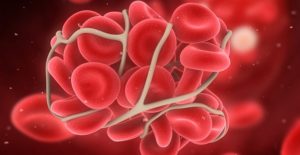What is Pulmonary Embolism?

Pulmonary embolism is a blockage of a pulmonary artery, which is a blood vessel in the lung. Pulmonary arteries bring deoxygenated blood from the right side of the heart to the lungs, and this allows oxygen to be absorbed by the blood. Given the role of these arteries, pulmonary embolism is a serious medical condition.
When a pulmonary artery is blocked, the ability of one or both lungs to give oxygen to the blood is greatly reduced. Since oxygen is necessary for the survival of all tissues in the human body, pulmonary embolism can be fatal. However, with prompt treatment, many patients make full recoveries.
Causes
Pulmonary embolism occurs when a blood clot travels through the bloodstream to the right side of the heart. Once there, the clot is pumped into the pulmonary circulation, and if the clot is sufficiently large, it becomes wedged in one of the lung's arteries. This type of blockage partially or totally blocks blood flow through the affected area.
In a majority of cases, patients diagnosed with pulmonary embolism will have histories of a medical condition called deep vein thrombosis. Often referred to as DVT, deep vein thrombosis is the formation of a blood clot within a vein in the leg. This is the single biggest risk factor for pulmonary embolism because the veins in the legs lead directly back to the right side of the heart. Thus, most cases of pulmonary embolism are preceded by a sudden freeing of a clot in the leg.
Symptoms
The two most common symptoms of pulmonary embolism are shortness of breath and chest pain. In fact, a patient with pulmonary embolism may initially seek medical treatment out of fear that he or she is having a heart attack. The chest pain may become worse while bending, coughing, or exercising, and the rapid onset of shortness of breath associated with pulmonary embolism can be quite alarming. Coughing up blood is also noted in some cases.
In addition to the primary symptoms, some patients experience one or more of the following: leg pain or swelling, clammy or bluish skin, excessive sweating, rapid heartbeat, or dizziness. These symptoms arise from the body's inability to obtain enough oxygen.
Treatments
Luckily, advancements in medical science and technology have generated many effective treatments for pulmonary embolism. The first line of defense for less serious cases is a medication that thins the blood. A special type of drug called a thrombolytic is also given. Thrombolytics dissolve blood clots.
For very large clots, a minimally invasive surgical technique called catheter-directed thrombolysis has improved the recovery rate of individuals with severe pulmonary emboli. This method involves inserting a catheter into a vein and directing it to the location of the clot. The clot can then be broken into smaller pieces, treated directly with thrombolytic, or even completely removed.
Since pulmonary embolism is potentially fatal, seek treatment immediately if you experience sudden shortness of breath and severe chest pain.







